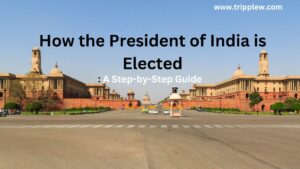
Welcome to Triple W! Here in this blog post we are providing a deep insight on –
How the President of India is Elected: A Step-by-Step Guide
The President of India holds the highest constitutional office in the country, embodying the unity and integrity of the nation. But how is the President of India elected? The process is intricate and designed to reflect the democratic and federal nature of the Indian political system. Let’s break down the procedure in simple terms.
The Election Process of the President of India
Electoral College
The President of India is elected by an electoral college that includes elected members of both Houses of Parliament and the Legislative Assemblies of all states, including Union Territories like Delhi and Puducherry. This system ensures that both national and state interests are represented in the election.
Value of Votes
Every vote cast in the Presidential election does not carry the same weight. The value of a Member of Parliament (MP)’s vote differs from that of a Member of Legislative Assembly (MLA). The value of each MLA’s vote is calculated based on the population of the respective state, while all MPs have a fixed vote value.
Proportional Representation
The President is elected through a system of proportional representation by means of a single transferable vote. Voters rank their preferences, and the candidate who secures more than half of the total value of valid votes is declared the winner.
Voting Process
The election is conducted via secret ballot. MPs and MLAs cast their votes in separate ballot boxes for their respective groups. To win, a candidate needs to secure the required quota, which is determined by dividing the total value of votes by two and adding one.
Nomination
A candidate must be proposed by at least 50 electors and seconded by another 50 electors to file their nomination. This is to ensure that only serious candidates contest for the highest office.
Term and Eligibility
The President is elected for a term of five years and can be re-elected. Any Indian citizen who is 35 years of age or above, qualified to be a member of the Lok Sabha, and meets other criteria is eligible to stand for the election.
Conclusion
The election of the President of India is a well-thought-out process that mirrors the democratic principles of the nation. It balances the voice of the states with the representation of the people through their elected MPs and MLAs, making it a unique system in the world.
—
Disclaimer : The content provided in this article “How the President of India is Elected: A Step-by-Step Guide” is for informational purposes only. While every effort has been made to ensure the accuracy of the information, readers are advised to verify the details from official government sources. This blog does not offer legal advice or any professional services.